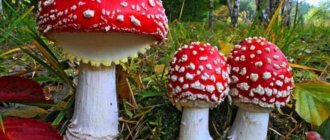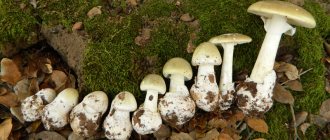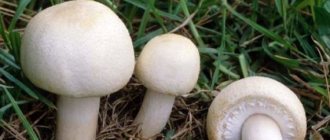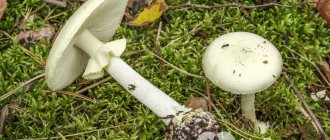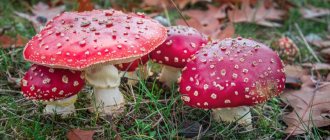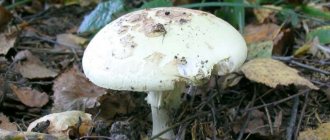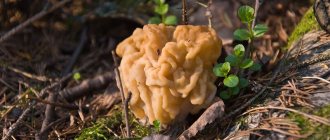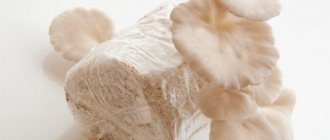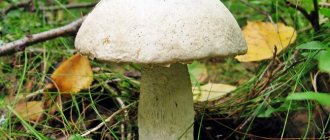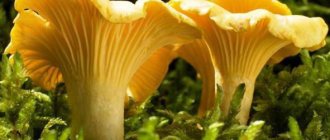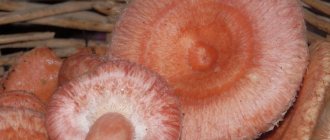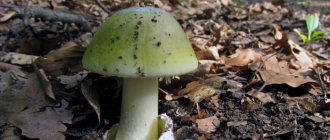05/31/2019 Category: Mushroom poisoning
- refers to poisonous mushrooms
✎ Affiliation and generic characteristics
Death cap
- the most dangerous of all poisonous mushrooms, and received this name for the pale color of its fruiting body.
It belongs to the fly agaric genus
, which is why it is also called
the pale fly agaric
.
✎ Similar species
Pale grebe
inexperienced mushroom pickers can easily confuse it with
forest champignon
, from which it differs in white plates (in champignon they are either pink, or light brown, or blackish-violet), as well as a longer leg with a bag-like thickening (in the form of a sheath) at its base, which is completely absent from champignon.
The spores of the toadstool are no less dangerous and poisonous than the toadstool itself. Carried by the wind, they fall on nearby plants, mushrooms and berries, infecting them with their poison. Therefore, you cannot pick edible mushrooms
and berries, even close to it - it is not at all safe! The poison contained in the pulp of the toadstool is not destroyed by any heat treatment. And the main danger of poisoning by toadstool is that obvious signs of poisoning do not appear immediately, but after several hours, during which irreversible damage processes already begin to occur in the human body and precious time for healing becomes irretrievably lost. Therefore, treatment becomes delayed and sometimes meaningless, which leads to death. Even despite the improvement in health on the third or fourth day after poisoning, the process of destruction of the liver and kidneys continues in the body, and death can occur ten to twelve days later. Such an incredible danger lies in this terrible mushroom and the mortality rate from its poisoning is at least 50 percent!!!
✎ Distribution in nature and seasonality
Death cap
It grows, as a rule, in the southern part of the forest zone. It is found, most often, in the central regions of Western Europe, central Russia, the Urals, Siberia and the Far East. The pale grebe lives in coniferous and deciduous forests, often oak, along forest edges and forest clearings, both alone and in small groups, from mid-July to the end of September.
✎ Brief description and application
Death cap
refers to
lamellar mushrooms
.
Her plates are loose and frequent, white in color. The cap is first cone-shaped, then straightens and becomes flat, it is silky and sticky to the touch in pale shades of gray, pink, yellow, green, brown and, almost never, white, without flaky scales (like fly agarics )
. The leg is straight, high, with cotton flakes, a fibrous wide ring and a bag-like cover at its base, white. The pulp is elastic, fleshy, but at the same time thin, white in color, which does not change when damaged, with a sweetish, but very unpleasant odor. It is strictly forbidden to taste it, the mushroom is deadly poisonous!!!
Anyone who likes to cook dishes from freshly picked mushrooms needs to know their main types. Otherwise, there is a possibility of getting poisoned by eating a poisonous mushroom instead of a regular one. The toadstool is especially dangerous; poisoning with it can lead to death, which you need to learn to distinguish from edible mushrooms.
Difference between toadstool and other mushrooms
Pictured is a pale grebe
This is a very dangerous mushroom, since in most cases a person dies from toadstool poisoning. Therefore, getting to know its appearance is one of the most important rules that a person must follow before going into the forest.
The pale grebe usually has:
- The cap is egg-shaped or flat and convex, with a dry or slimy surface, up to 12 cm in diameter, green to yellowish or off-white to brownish in color, with dark fibers ingrown into it;
- White growths in the form of warts on the cap; older mushrooms may not have them, and they may also disappear after rain;
- The cap plates are white, thin;
- The pulp is white;
- The leg is up to 15 cm long and up to 2 cm wide, thin, widening towards the base, white, white-green or white-yellow;
- Volva - a formation at the lower base of the leg in the shape of a cup, white, loosely in contact with the leg, and extends a few centimeters;
- The ring is a formation at the upper base, also white.
The main difference between toadstool and other mushrooms is the presence of a volva and a ring, so they are always cut off at the base to make sure of this. Champignons, for example, do not have a volva, and the float does not have a ring and is smaller in size. Having cut off a mushroom that looks like a toadstool, it is better to play it safe and throw it away than to look for other distinctive features.
Toadstools can be confused with edible mushrooms, but such confusion can cost lives. To have a more complete picture, you need to know what harm this poisonous mushroom can cause to the human body.
Where do mushrooms live?
They live
in soil, on living organisms and their remains.
Mushrooms
can be found in sea water, in desert sands and high in the mountains.
Among fungi
there are unicellular and multicellular organisms. These organisms are classified as eukaryotes because their cells have a nucleus.
Interesting materials:
KBK 104 what to enter in the payment order? What is KEP? CEP what? Chum salmon or pink salmon, which is tastier? Hedging what? What is clearing? Clearing what? How can I find out the code of the executive body of the FSS? Collective agreements or agreements, which is correct? What is included in the average salary for business trips?
The effect of the venom of the pale grebe on the human body
Pale grebe has a deadly toxin
The pale grebe is so poisonous due to the dangerous substances it contains: phallus and amatoxins. The former are less poisonous, but spread through the blood faster and cannot be eliminated by heat treatment. The latter are more poisonous, but do not act as quickly. They are not digested in the stomach, but enter the liver, which is the first to be destroyed.
Getting first into the stomach and then into the blood, the toxins do not manifest themselves in any way for several days.
Even the destructive effect on internal organs is initially unnoticeable; this is called the latent period. During this period, a person does not experience symptoms of poisoning, but toxins trigger irreversible processes in the body, such as tissue necrosis.
Among these processes are:
- Inflammation of the stomach;
- Destruction of the integrity of the liver and disruption of its functioning;
- Destruction of the structure of the intestines and other organs;
- Metabolic failure;
- Decreased blood glucose levels;
- Disruption of the central nervous system.
After several days of exposure to toxins on the body, providing assistance to a poisoned person is unsuccessful. Therefore, even if you have the slightest doubt about your condition, you should go to the hospital. This should also be done if there are symptoms that can be used to determine poisoning before the situation worsens.
Vomiting, thirst, diarrhea, colic, abdominal cramps, dizziness - all this may indicate poisoning with toadstool.
Depending on the amount of poison entering the body, the person’s reaction to it and the period of poisoning, symptoms are divided into several groups:
- Symptoms of the latent period. As mentioned above, during this period there are no signs of poisoning. Their absence can last from 7 hours to two days, usually about 12 hours. This time is an important criterion when making a diagnosis. But the longer it lasts, the more difficult the disease progresses. During this period, it is impossible to establish poisoning, although the poison is already destroying the body;
- Pronounced symptoms. The duration of this period ranges from one to several days. Here the first symptoms begin to appear: incessant diarrhea with vomiting, thirst, colic and abdominal cramps. Thirst is practically not quenched; all the liquid drunk is immediately expelled through vomiting. Dehydration lowers blood pressure, the face becomes pale, lips turn blue, the color of nails changes, and the heartbeat increases. There may be a headache, dizziness, and blurred vision. Muscles cramp, arms and legs become cold;
- Imaginary recovery. This period lasts up to a day. The poisoned person seems to be recovering and the symptoms of the second period disappear. Analyzes done at this time show the opposite. If the disease is severe, death is possible on the third day. This period is decisive;
- Destruction of the body. If after three days of illness no help was provided, the person’s eyes, mouth, and other mucous membranes turn yellow. There is pain and heaviness under the ribs on the right side. The symptoms of the second period return: diarrhea, abdominal pain. The kidneys stop working, toxic hepatitis develops. Death can occur from kidney failure, liver damage, and heart failure. This happens in severe cases and untimely consultation with a doctor.
Death occurs with severe poisoning. If you ask for help in time, this will not happen.
Toxic properties of red fly agaric
Few mushrooms can surpass the fly agaric in toxicity; species belonging to the class of Agaricomycetes are almost always characterized by increased toxicity. The largest amount of toxic substances is contained in the cap and base of the mushroom stem. This type of mushroom contains the following toxic substances:
- ibotenic acid; - muscarine; - muscimol.
Muscarine, which is present in large quantities in the red cap, has a pronounced intoxicating effect on the human body. Poisoning with this substance is indicated by vomiting, increased salivation, decreased blood pressure and increased sweating. Muscarine reduces cardiac output. In severe cases, a person may experience an attack of suffocation due to bronchospasm and pulmonary edema. Convulsions, disturbances of consciousness and death are possible.
The largest amount of toxic substances is contained in the cap and base of the mushroom stem.
Ibotenic acid has a negative effect on the condition of brain cells. In addition, this substance, along with muscimol, has a psychotropic effect. Cases of fatal poisoning are extremely rare. One fruit that accidentally ends up in a mushroom picker’s basket contains too few toxic substances for them to cause death. It is believed that a lethal dose of poisons is contained in 12-15 caps.
Use as an insecticide
Fly agarics can be used to prepare an insecticide. In fact, the poisons contained in this mushroom do not lead to the death of insects. Flies that drink fly agaric infusion fall asleep and then drown. Thus, if you take out a sleeping insect and place it on a dry surface, after 10-12 hours it will come to life and fly away.
Infusion of fly agaric.
To prepare the insecticide, you need to finely chop the fruit, place it in a plate and cover with cold water. The composition will infuse for 24 hours and will begin to attract flies. It will emit a pleasant smell for insects. The finished product can be used for a long time. You can periodically add water to the composition.
If an old fly agaric with a concave cap was found in the forest, you can shake out the spore powder from it and pour water onto the cap, into which alkaloids will quickly be released from the pulp. Flies will quickly drown in the liquid located in the center of the concave cap.
First aid for poisoning with toadstool
If you are poisoned by toadstool, call an ambulance
First aid will not have a noticeable effect, but may relieve symptoms. Before this, you must call a doctor and provide first aid while the ambulance is traveling. If toadstool poisoning is suspected, first of all induce vomiting, clearing the stomach, and neutralize the effect of toxins:
- Take half a liter or a liter of clean water, drink it, and then induce vomiting. The procedure is repeated several times;
- Activated carbon or other sorbents are taken according to the instructions.
These actions are not treatment, and doing them yourself is useless.
First aid will only help to properly use the time before the doctor arrives. Anyone who may have been poisoned, even without symptoms of the disease, should go to the hospital.
The treatment itself is difficult and includes a complex to remove poison. Various drugs are used, but one that can cure this particular disease has not yet been invented.
Treatment for poisoning
There is no universal cure for poisoning with toadstool. The effect of the poison can be removed with some antibiotics. Treatment is aimed at reducing the intensity of symptoms and neutralizing toxins:
- The stomach is washed regardless of whether this was done during first aid.
The mushroom may not have completely come out of the stomach because it is not digested; - If the poisoning occurred no more than three days ago, use benzyl penicillin 6 times a day at a dosage of 500 thousand - 1 million per kilogram of weight. For up to 12 days, silibinin is used at a dosage of 30 mg per kilogram of weight per day. It is possible to use lipoic (thioctic) acid;
- To prevent dehydration, crystalloid solutions are administered intravenously. Due to the decrease in glucose levels, it is also introduced into the body. The patient is given salt water to replenish chlorides;
- Forced diuresis and extracorporeal detoxification are used to remove toxins. Their essence is to stimulate the functioning of the necessary organs in order to eliminate toxins;
- They give medications that support the cardiovascular system, toning it up;
- Enzymes are used to reduce blood clotting;
- To restore the functioning of the liver and kidneys, the patient is given vitamins.
In case of poisoning with toadstool, treatment is limited to reducing and neutralizing toxins, carried out only in a hospital under the supervision of a doctor
These are the main methods of treatment. The rest depend on the severity of the disease and the patient’s condition. Each case is individual, but if you go to the hospital within 36 hours after poisoning, the chances of recovery increase.
Although recovery is possible, it is never easy. After taking the right medications and receiving medical care, it is important to follow some measures to avoid making the situation worse.
Fly agarics in the diet of animals
Which animal eats fly agarics and do such animals exist? Zoologists have long noted that forest inhabitants such as bears, moose, deer and squirrels often do not hesitate to eat certain types of fly agarics, for example, the well-known red fly agaric. Initially, such actions were associated with the fact that animals liked the hallucinogenic effect of eating mushrooms.
Later, it turned out that eating fly agarics helps forest residents get rid of parasites that poison the animal’s body.
It is worth noting that, despite the fact that man, to some extent, is also a representative of the animal world, the digestive system and enzymes that help digest food are still different. And the fact that for wild animals that eat fly agarics can be salvation, for humans it can cause irreparable harm and even mortal danger.
Prevention of poisoning by toadstool
Following the rules after treatment will help avoid serious consequences of poisoning. This may be either the failure of some organs or the development of other diseases, which may result in a repeated visit to the hospital.
You must follow all doctor's instructions.
Typically this may involve diet and taking prescribed medications. Also, after leaving the hospital, it is advisable to be observed in the hospital for some time in order to eliminate the troubles described above.
To be sure that a mushroom collected in the forest is not a toadstool, it is better to:
- Do not collect suspicious, toadstool-like, strange-looking mushrooms;
- Familiarize yourself with the main types of edible mushrooms and be guided by this knowledge when collecting;
- Do not collect mushrooms that have a volva and a ring at the same time, or one or the other, if you are not sure of its edibility;
- Remember that toxins are not killed by heat treatment.
And do not forget that the white toadstool is one of the most poisonous mushrooms in the world. Knowing about its effect on the human body and what it looks like, avoiding such mushrooms is the best prevention against poisoning.
Watch a video about the toadstool and how to distinguish it from other edible mushrooms.
Pale toadstool is considered the most poisonous mushroom in our area. Moreover, all its parts are dangerous. It is strictly not recommended to collect these mushrooms, since even with the slightest contact with the edible type, the poison of the toadstool is quickly absorbed into the caps and stems of a good mushroom. Outwardly, the toadstool does not cause any suspicion; it has a pleasant smell and taste. Often, instead of honey mushrooms, they bring poisonous toadstools, or they confuse it with other species. Therefore, you need to know the distinctive features to avoid poisoning and more serious consequences.
MUSHROOM POISONING IN PETS
Acute or unexpected (sudden) poisoning of pets is one of the pressing problems that worries owners, although in veterinary practice they do not occur very often (1–2% of all cases of disease). Most often, the cause of such sad incidents is the inattention of the owners, and the victims are mainly dogs and cats.
Since by their nature dogs and cats (especially young ones) are very curious creatures, when exploring the world around them, they can easily encounter toxic substances, poisonous plants and mushrooms, corpses of animals killed by poison (mice, rats), etc. It is common knowledge that many dogs and cats taste “wild” mushrooms while walking (especially in the garden, on the property, in the forest or in the field). Dogs have been noted to have a particular interest in the toadstool (Amanita phalloides), the stinking fly agaric (A. virosa) and the toxic toadstool (Inocybe), possibly due to their somewhat fishy odor. Pale grebe is generally well known to veterinarians around the world as a source of deadly threat to dogs (I suspect that in many cases veterinarians confuse it with the stinking fly agaric), but muscarine-containing fibers and talkers (Clitocybe) also pose a serious threat, since dogs are much more sensitive to muscarine in comparison with people. A dose of muscarine that does not pose a threat to human life will definitely be lethal for a dog. It is now a reliable fact that immature puffballs (Scleroderma) also pose a mortal threat to dogs and pigs. Practically safe for humans, incapable of causing any consequences more serious than severe gastroenteritis, some yet unknown (safe for humans) poisons of rainflies are extremely dangerous for the mentioned animals. Here we can see an analogy with the selectively active toxin of the lichen Letharia vulpina, which is lethal to predatory mammals and harmless to herbivores.
Red and panther fly agarics are also common causes of intoxication in dogs because they seem to have an attractive odor to them. Ibotenic acid and muscimol are not lethal to humans, but in dogs they can be fatal in some cases. Cats, although they very rarely consume fresh mushrooms[1], for unknown reasons, have a huge craving for dried caps of the red and panther fly agarics, prepared for medicinal or other purposes. There are about a dozen cases of fatal poisoning in cats caused by dried fly agarics. As a rule, after eating fly agarics of these types, both dogs and cats experience a long sleep. As practice has shown, the use of atropine in this case can transform such sleep into a coma, which significantly increases the likelihood of the animal’s death. Therefore, as in the case of people, when poisoning dogs and cats with red or panther fly agarics, it is best to be patient and wait until the animal returns to normal on its own. Recovery usually takes from 6 to 72 hours.
Many dogs die every year from eating mushrooms containing amatoxins (primarily toadstool). As in humans, the clinical picture in this case is characterized by a 6-12 hour delay in the onset of the first symptoms, which are expressed in acute gastroenteritis, refusal to eat and drink. In the USA, in addition to the toadstool, Amanita bisporigera and A. ocreata pose a similar threat to dogs. There is no specific treatment for this case, but there is an interesting report of a recent case in California where a dog was saved by intensive rehydration and injection (syringe) of bile from the gallbladder.
An absolute threat to dogs, as well as to kittens and young cats, are the ripe fruiting bodies of large puffballs in the spore spreading stage. Young active animals that start playing with such “balls” while out for a walk often become victims of lycoperdonosis by inhaling allergenic spores. Such cases occur around the world every year.
We should not forget about edible mushrooms, which can pose a threat to the health of your pet if they were found and eaten by him near sources of anthropogenic pollution (intensively exploited agricultural landscapes, industrial enterprises, roadsides). Veterinary statistics indicate cases of poisoning of dogs by pesticides, herbicides, chemical fertilizers and heavy metals contained in edible mushrooms.
However, much more often, dogs and cats “earn” mycetism not in nature, by tasting a toxic mushroom or inhaling allergenic spores of raincoats, but together with their owners, when they treat them to soup, which mistakenly contains deadly species (primarily those that contain amanitines or muscarine)[2]. The most poisonous mushrooms for dogs and cats in this regard are considered to be pale toadstool, spring and stinking fly agaric, red and panther fly agaric, muscarine-containing talkers, sulfur-yellow false foam, false puffballs, poisonous southern boletus. The poisons of these mushrooms have a toxic effect on the cardiovascular system, central nervous system, gastrointestinal tract, liver, kidneys, i.e. on almost all vital organs of dogs and cats.
Symptoms of poisoning are usually the following: the animal constantly feels sick, vomits, she moans due to abdominal pain, diarrhea is usually bloody; there is increased thirst; body temperature drops to 35-36° C; the pulse is slow and barely detectable; consciousness in severe conditions is darkened; the dog and cat do not recognize the owner, lie motionless, the dogs do not respond to the name.
Before calling a veterinary ambulance, you should rinse your pet’s stomach with water or a pale pink solution of potassium permanganate; introduce activated charcoal into the stomach; drink strong sweet tea, coffee with milk, then pour castor oil inside (from 1 teaspoon to 100 g, depending on body weight); Briefly apply a cold compress, cold water heating pad, or ice pack to your head.
Meanwhile, mushroom poisoning in domestic animals does not always occur by accident. Some peoples of the world have a tradition of using them as “biotesters” of the edibility or toxicity of mushrooms. In approximately the same capacity as before, wealthy people kept special dogs (or even “mushroom people”) to check dishes for poisons in general and mushroom poisons in particular. In Chile, for example, unfamiliar mushrooms are tested on guinea pigs. In Nigeria, they are crumbled to chickens, and on the islands of Polynesia, controversial mushrooms are offered to pigs.
Despite the exotic nature of mushroom poisoning in pets, owners should exercise a certain amount of caution and attentiveness when taking their pet for a walk to places where he may encounter poisonous mushrooms.
[1] Cat poisoning by mushrooms is a rare pathology. For example, the Veterinary Poisons Information Center in the UK has received 867 canine and only 57 feline samples relating to potential mushroom poisoning over the past 10 years. Similarly, the Veterinary Poison Control Center in the United States receives an average of only 6 samples per year from cats.
[2] There are quite exotic cases of fungal intoxication in domestic animals. These, for example, include the death of a cockatoo parrot, which died together with its German owner, who had prepared soup from pale toadstools and treated the bird to a mushroom from a plate. Dogs have been poisoned by mushrooms of the genus Psilocybe, which owners “share” with them (or do not prevent them from eating when collecting hallucinogenic mushrooms). Symptoms include aggression, loud barking, chasing non-existent objects, ataxia, involuntary movement of the eyeballs, and increased body temperature. The animals “come to their senses” only after two or three days.
Distinctive features of the toadstool
The pallid grebe has a cap-footed body. The cap has a yellowish color and ranges in size from 4 to 12 cm. At a young age, there are white warts on its surface, which are absent in adult fruits. The leg has a cylindrical shape, 10-15 cm in size. At the top of the leg there is an erect white ring.
Young toadstool fruits can be confused with russula, champignons, rows, and often bear poisonous toadstools instead of honey mushrooms.
You can distinguish this mushroom from russula by the following characteristics:
- Russula lacks a tuberous thickening and a volva;
- Russula has a smooth and straight leg without a ring.
The difference between the pale toadstool and the champignon is not always immediately visible. Their legs are exactly the same. You can tell by the plates on the inside of the cap. In the toadstool it is always white; the champignon has pinkish or brown plates with age. Young fruits, given the description of the pale toadstool, are very difficult to distinguish; only an experienced mushroom picker can do this, relying on his intuition. If there is even the slightest doubt, it is not recommended to collect such mushrooms.
Description of the red fly agaric
It belongs to the class Agaricomycetes. Even young children know the description of the red fly agaric. However, many interesting facts about fly agarics are unknown even to avid mushroom pickers.
The fly agaric Muscari Amanita is most well recognized due to its red cap, the diameter of which ranges from 8 to 20 cm. Depending on the degree of maturity of the mushroom, its shape can range from hemispherical to flat and even concave. There are many white warty flakes on the surface of the cap. They can fall off under any mechanical impact. They often wash off when it rains.
Fly agaric Muscari Amanita.
Ripe fruits have cream or white plates on the caps, the width of which ranges from 0.8 to 1.2 cm. They are located often and hang freely. Red fly agarics have many intermediate plates. What spores look like can only be seen under a microscope. They have an ellipsoidal shape and a smooth surface. Spore powder is white.
The leg has a cylindrical shape. Its diameter can reach 1-2.5 cm. It is hollow inside in mature fruits. The height of the leg is 8-20 cm. The color of the leg can vary from white to beige-yellow. Almost at the cap itself there is a ring-skirt on the stem; its length can reach 2.5 cm. The surface of the ring is lumpy, and its edges are uneven. The color of the skirt can be white or brownish. Like many other poisonous mushrooms, fly agaric mushrooms have a thickening on the stalk near the base, called tuberous by biologists.
The fruits are distinguished by white flesh with a slight mushroom smell. Only under the skin of the cap can it have a yellowish color. The more mature the mushroom, the stronger the smell.
Properties and toxicity of toadstool
Pale grebe contains very strong toxins, which, if ingested in the body at a concentration of 1 gram per 1 kg of body weight, lead to death. If a small part of the poisonous pulp gets into a dish, it makes the entire batch toxic. The mushroom contains 2 types of alkaloids:
- Amanitin is a very strong slow-acting poison
- Phalloidin is a fast-acting substance that is no less toxic.
These poisons have a destructive effect on the kidneys and liver of a person, killing him in just a few days. The danger is that the first signs of poisoning can occur even on the second day, and during this time necrosis of all tissues develops from the action of toxins. After several days of this action, treatment often does not bring any results.
In addition, the mushroom has some positive properties:
- Igo can be used for homeopathic purposes as an antidote to certain types of poisonous mushrooms.
- Injections with minimal doses of toadstool toxins are administered to improve the health and rejuvenation of the skin.
- In folk medicine, tinctures are made from toadstool to treat cancer.
- Some use the mushroom as a means of combating harmful insects.
However, the benefits of the toadstool are minimal compared to its danger, so you should avoid any contact with it.
Composition of fly agarics
Given the wide variety of these mushrooms, it is quite difficult to write generally about the composition. It turns out that all representatives of the fly agaric genus are rich in fiber, proteins and vitamin and mineral components. But, given the specifics of the genus, the benefits of fly agaric are most often outweighed by the harm it causes. Therefore, it would be most logical to consider the composition, dividing plants into subgroups according to the degree of edibility and danger to humans.
| Danger level | Popular representatives of fly agarics | Compound |
| Great edible | Caesar and Caesar-like | This category is rich in succinic, citric, malic and other organic acids. It is also a source of vitamins B and C, potassium, zinc, and phosphorus. |
| Good edible | Ovoid and grey-pink | They contain the toxic compound betaine, which is used to treat liver diseases and is used in drugs that alleviate the condition of Alzheimer's disease. As well as a number of toxins that are dangerous for animals, but not dangerous for people: rubescenslysin, flammutoxin, virotoxins. These substances are not absorbed by the human digestive system, but, nevertheless, they can cause harm, although to a lesser extent than to representatives of the animal world. |
| Conditionally edible | The float is strange and orange | These mushrooms contain a large amount of water (almost up to 80%). Rich in potassium, phosphorus, sodium. They are a source of nicotinic acid, vitamins B and C. The toxins contained in these mushrooms are dangerous in the absence of sufficient heat treatment. |
| Inedible | Gray and knobby | In this category, mushrooms are still rich in vitamin and mineral components, but due to little research, it is impossible to say whether they contain toxins dangerous to humans and in what quantity. Although, some sources contain information that these mushrooms are quite edible. |
| Toxic | Red and Royal | Mushrooms contain poisonous alkaloid compounds such as ibotenic acid, muscarine, muscaridine, betanin, as well as chitin and essential oils. |
| Deadly poisonous | Various types of toadstools | Mushrooms of this category contain phalloidin, amanitin and protein toxin in large quantities, which are deadly to humans even in microdoses. |
Symptoms of poisoning
The symptoms that appear will depend on the amount of mushroom eaten. There are stages of poisoning, which will have their own characteristics:
- Latent phase. There are no symptoms during this period. Typically, exposure to toxins occurs within 12 hours before the first unpleasant signs appear, although it can last up to 2 days. It is almost impossible to establish poisoning at this stage; the longer it lasts, the less chance there is to save the person.
- Acute period. It begins after the appearance of symptoms of intoxication and lasts 1-2 days. A person suffers from severe pain in the stomach and head, diarrhea, vomiting, unquenchable thirst, and dizziness. The skin turns blue, the heartbeat quickens, the extremities are cold, and are prone to convulsions. Signs of dehydration of the body are also clearly expressed.
- Relief stage. It is characterized by the fact that the person feels better, acute symptoms subside, and the patient believes that he is recovering. The severity of the situation can be determined by tests; if they are far from normal, then death is possible on the third day.
- Complete destruction of the body. If after 3 days a person has not received the necessary medical care, then all internal organs are destroyed. Vivid symptoms resume with greater intensity, the mucous membranes begin to turn yellow. Death can occur due to renal failure, problems with the liver and heart.
This outcome only happens when poisoning with toadstool poisons occurs in large quantities, or the victim was not provided with timely assistance. In the best case, a person can almost always be saved.
First aid
At the first symptoms of poisoning, a team of medical workers is first called. Before their arrival, you need to provide first aid to the victim yourself in order to reduce the risk of irreversible consequences for human health and life.
First of all, a person needs to do a gastric lavage. To do this, you can use a weak solution of potassium permanganate, or plain warm water, dissolving salt in it: 1 tablespoon per glass of water. You need to drink at least 1.5 liters of liquid at a time. Then induce vomiting by pressing on the root of the tongue with your fingers.
After washing the stomach, the victim should be laid down and a warm heating pad should be placed on the lower extremities and abdomen. Give a sorbent to drink, or activated carbon at the rate of 1 tablet per 10 kg of body weight.
Further treatment is carried out by medical specialists after determining which fungus provoked the intoxication (if the patient’s vomit is preserved, it can be used for laboratory testing of the nature of the toxins).
Treatment will primarily be aimed at eliminating dehydration and relieving intoxication; for this purpose, saline solution and glucose with insulin are infused by drip. Next, some antibacterial drugs are prescribed that have antidote properties. Therapy is also carried out to maintain the functioning of the heart, kidneys and liver.
Treatment takes a very long time, up to 4 weeks. If the therapy gives positive results, then the prognosis is favorable and recovery and complete restoration of the functions of all internal organs and systems will soon occur.
White toadstool is a very dangerous mushroom that has minimal differences with edible species. Therefore, if you do not have good knowledge in the field of mushrooms, it is better not to deal with this matter yourself, but to trust the specialists.
Not a single mushroom causes such destructive harm to the human body as the white toadstool. This is the most dangerous and poisonous mushroom. Eating it causes severe poisoning, treatment for which must be started as quickly as possible. But this dangerous mushroom itself, or rather its individual components, can help in the treatment of cancer.
Appearance
The pale grebe can be found in coniferous and deciduous forests. It grows in groups, occasionally singly, throughout the summer and until the onset of frost.
The pale grebe is very poisonous. The mushroom contains deadly poisons: phallotoxins and aminotoxins. All parts of the mushroom are poisonous, including the spores. Even the juice remaining on the knife after cutting a mushroom is enough to poison a person.
Pale toadstool has white flesh and a pleasant mushroom aroma. Inexperienced mushroom pickers often confuse toadstool with ordinary edible champignons, russula, and honey mushrooms. In contrast, the pale grebe has a tuberous swelling on the lower part of the leg, and a ring in the form of a white “skirt” at the top.
The venom of the toadstool cannot be neutralized by heat treatment.
Places of growth
This mushroom is found in temperate climate zones of the Northern Hemisphere. Red fly agaric is found in deciduous, coniferous and mixed forests, but most often it forms mycosis with birch or spruce. This mushroom prefers soils with high acidity. This variety can grow on neutral soils, but they hardly produce fruit in such conditions. The fly agaric mushroom bears fruit from August to September. To begin the formation of fruits in the mycelium, damp weather and a sharp temperature change are required.
The red fly agaric is found in deciduous, coniferous and mixed forests.
The effect of poison on the human body
When even a small particle of the fungus enters the gastrointestinal tract, the body becomes intoxicated. The liver and kidneys are mainly affected, where the poison concentrates.
Under the influence of poisons, liver cells die and liver failure develops, and kidney degeneration occurs. All human organs are gradually affected. If time is wasted and urgent measures are not taken, treatment may be useless. All medications will be powerless against intoxication.
Children and the elderly suffer the most severe poisoning, with the largest number of deaths among them.
Timely seeking medical help at the slightest suspicion of toadstool poisoning will reduce the likelihood of death by 50%.
If even a small piece of mushroom enters the body, poisoning occurs.
Help with poisoning
At the slightest sign of poisoning, you should immediately call an ambulance or take the victim to the hospital in some other way. Otherwise, treatment may be unsuccessful.
Before the ambulance arrives you should:
- Rinse the stomach, drink 5-6 glasses of warm boiled water.
- Induce vomiting. Repeat the procedure several times.
- Take a laxative. Castor oil can be used as a laxative.
- Give an enema. All this is done with the aim of cleansing the stomach and intestines of food containing poison.
- Lie in bed and apply warm heating pads to your limbs.
- Do not consume food or alcoholic beverages.
A person’s life depends on how quickly treatment is started.
At the slightest sign of mushroom poisoning, you need to urgently call an ambulance
Use in medicine
In folk medicine, fly agarics are used to treat many diseases. It is believed that the active substances and vitamins contained in this mushroom can alleviate the course of certain types of cancer. Traditional healers prepare such remedies from young fruits. Decoctions cure skin diseases, incl. psoriasis and eczema. To prepare the product, you need to boil 2-3 fruiting bodies, then grind them into a paste and apply to the affected area of the skin.
Use in medicine.
Some northern peoples use compositions based on this fruiting body to remove helminths. It is believed that infusions have a pronounced immunostimulating effect, and therefore can be used in the treatment of viral infections. Traditional healers also treat joint diseases with this mushroom. For the treatment of pathologies of the musculoskeletal system, alcohol tinctures based on fly agaric are used. However, it must be taken into account that science has not proven the effectiveness of using these poisonous fruits in the treatment of certain diseases.
Reanimation
There is only one recipe for treating a patient with toadstool poisoning - eliminating dehydration, detoxification and preventing death. Treatment begins with the use of various plasma substitutes, which are administered in a volume of at least 3–5 liters per day using a dropper. In case of poisoning, a drop in blood pressure is observed, and measures are taken to increase it. To do this, norepinephrine or mesaton is administered. Hydrocortisone or other medicinal analogues are used to support the liver. If there are signs of heart failure, strophanthin and corglycone are used.
When going to the forest to pick mushrooms on an autumn day, you need to remember that not every mushroom that attracts with its external attractiveness is safe for health. Among the vast kingdom of mushrooms, the toadstool is particularly insidious. It has a pleasant mushroom aroma and taste that can win the heart of a gourmet. But at the same time, it is the most insidious and dangerous among poisonous mushrooms.
The ancient Roman emperor Claudius, seduced by the exquisite taste of mushrooms, could not contain his delight and ordered such mushrooms to always be served to him from now on. However, the wish was not destined to come true; poisoning with toadstool occurred very quickly. Claudius died from a lethal dose the next day.
Distinctive features of the mushroom
Inexperienced mushroom pickers often become victims of the poison of the toadstool. It is often mistaken for green russula, champignon, or greenfinch. However, the toadstool has significant differences that you need to know about. The toadstool mushroom at a young age has an ovoid body, completely covered with a film. The cap is 5–15 cm, light olive or grayish in color, hemispherical or flat in shape. The flesh of the toadstool is fleshy, white, and does not change color when damaged. A distinctive feature of the mushroom is the presence of a well-defined volva, about 5 cm wide, which is practically absent in edible mushrooms.
Irreversible consequences
Poisoning with toadstool occurs after eating it. Not only the body of the mushroom is poisonous, but also its spores. They have the ability to be carried by the wind and settle on plants within a radius of up to three meters. Therefore, you cannot collect edible mushrooms that grow in close proximity to the toadstool.
After the poisonous mushroom has entered the body, the toadstool toxin does not act immediately, initially without showing any signs of poisoning. Some time after eating the toadstool, the first signs of poisoning appear. Symptoms of poisoning appear only after 8–36 hours, and by this time the body has already suffered irreparable damage.
To receive a lethal dose of poison, it is enough to eat 30 grams of the fruiting body. Due to its pleasant taste, toadstools cannot be distinguished from edible mushrooms. Its poisons are not digested in the stomach and are not neutralized even after prolonged heat treatment at 100 degrees, drying or freezing.
This dangerous mushroom contains a potent mushroom toxin - amanitin. It and phalloidin belong to the category of polypeptides. They primarily affect the cells of the liver, kidneys, central nervous system, damage the cells of the spleen and heart muscle.
There is practically no antidote for the strong toxic effect on the main human organs.
- At the first stage, there are no symptoms of poisoning, the victim feels great and does not suspect anything wrong.
- After 1–2 days, after damage to the mucous membrane of the small intestine, acute pain in the abdominal cavity, vomiting, and diarrhea begin.
- Next comes a “period of imaginary well-being”, signs of improvement in the patient’s condition appear. The victim feels well and seems to be recovering, but the disease continues to progress.
- At the last stage of poisoning with toadstool, kidney and liver failure appears. At this stage, the victim may die.
The following symptoms are typical for poisoning with a poisonous mushroom:
- vomit,
- intestinal colic,
- stomach ache,
- thirst,
- diarrhea with blood,
- pallor of the skin and mucous membranes,
- convulsions and a drop in temperature are possible,
- muscle pain,
- blurred vision,
- the pulse weakens.
Degrees of poisoning:
- In case of mild poisoning, symptoms of moderate gastroenteritis and mild liver damage are observed.
- The average degree of poisoning is characterized by pronounced gastroenteritis, toxic damage to the liver and kidneys.
- Severe poisoning entails irreversible changes in internal organs, liver and kidney failure. Once such symptoms appear, the likelihood of death increases, and any treatment becomes useless.
In 90% of cases, poisoning with toadstool is fatal.
Poisoning with toadstool is characterized by vomiting and diarrhea.
Variety of fly agarics
Hearing just the name, our imagination pictures what fly agaric mushrooms look like in our head. We bet you immediately imagine a red riding hood with white polka dots on a thin leg, dressed in a cute skirt. It is not surprising, because among a green lawn such a forest dweller immediately attracts attention.
But in fact, the diversity of these plants is amazing, because scientists count about 600 species of fly agarics. And not all of them have a recognizable red hat. The mushroom that we have known from an early age is called the red fly agaric. But the family of these plants also includes the pale toadstool, Caesar mushroom, royal, pearl, toadstool, panther fly agaric and many more varieties.
Contrary to general misconception, in the fly agaric family there are not only deadly poisonous representatives, but also completely safe edible or conditionally edible individuals.
Safe edible fly agarics include Caesar and imperial. Conditionally edible fly agarics are called floaters - strange and yellow-brown. But deadly poisonous mushrooms include white and pale toadstools, green and white fly agarics. As for the popular red fly agaric, it is a toxic mushroom. It is capable of influencing the psyche, stupefying a person and causing hallucinations. Fatal consequences for humans are possible if you eat 10-15 whole plants.
